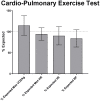Cardiac Performance and Cardiopulmonary Fitness After Infection With SARS-CoV-2
- PMID: 35647079
- PMCID: PMC9136046
- DOI: 10.3389/fcvm.2022.871603
Cardiac Performance and Cardiopulmonary Fitness After Infection With SARS-CoV-2
Abstract
Aims: Persistent cardiac symptoms are an increasingly reported phenomenon following COVID-19. However, the underlying cause of cardiac symptoms is unknown. This study aimed to identify the underlying causes, if any, of these symptoms 1 year following acute COVID-19 infection.
Methods and results: 22 individuals with persistent cardiac symptoms were prospectively investigated using echocardiography, cardiovascular magnetic resonance (CMR), 6-min walking test, cardio-pulmonary exercise testing and electrocardiography. A median of 382 days (IQR 368, 442) passed between diagnosis of COVID-19 and investigation. As a cohort their echocardiography, CMR, 6-min walking test and exercise testing results were within the normal ranges. There were no differences in left ventricular ejection fraction (61.45 ± 6.59 %), global longitudinal strain (19.80 ± 3.12 %) or tricuspid annular plane systolic excursion (24.96 ± 5.55 mm) as measured by echocardiography compared to a healthy control group. VO2 max (2045.00 ± 658.40 ml/min), % expected VO2 max (114.80 ± 23.08 %) and 6-minute distance walked (608.90 ± 54.51 m) exceeded that expected for the patient cohort, whilst Troponin I (5.59 ± 6.59 ng/l) and Nt-proBNP (88.18 ± 54.27 ng/l) were normal.
Conclusion: Among a cohort of 22 patients with self-reported persistent cardiac symptoms, we identified no underlying cardiac disease or reduced cardiopulmonary fitness 1 year following COVID-19.
Keywords: CMR; COVID-19; echocardiography; long-COVID syndrome; recovery following COVID-19.
Copyright © 2022 Wood, Kirkevang, Agergaard, Leth, Hansen, Laustsen, Larsen, Jensen, Østergaard, Bøtker, Poulsen and Kim.
Conflict of interest statement
The authors declare that the research was conducted in the absence of any commercial or financial relationships that could be construed as a potential conflict of interest.
Figures
References
-
- Center for Disease Control,. Post-COVID Conditions. (2021). Available online at: https://www.cdc.gov/coronavirus/2019-ncov/long-term-effects/index.html (accessed October 15, 2021).
LinkOut - more resources
Full Text Sources
Research Materials
Miscellaneous



